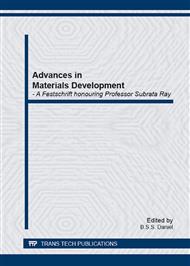[1]
J. Weissmüller, P. Bunzel, G. Wilde, Two-Phase Equilibrium in Small Alloy Particles, Scripta Mater. 51(8) (2004) 813-818.
DOI: 10.1016/j.scriptamat.2004.06.025
Google Scholar
[2]
J. Poh, C. Stah, K. Albe, Size-dependent phase diagrams of metallic alloys: A Monte Carlo simulation study on order–disorder transitions in Pt–Rh nanoparticles, Beilstein J. Nanotechnol. 3 (2012), 1-11.
DOI: 10.3762/bjnano.3.1
Google Scholar
[3]
C. Srivastava, S. Chithra, K. D. Malviya, S. K. Sinha, K. Chattopadhyay, Size dependent microstructure for Ag–Ni nanoparticles, Acta Mater. 59 (2011) 6501-6509.
DOI: 10.1016/j.actamat.2011.07.022
Google Scholar
[4]
Z. Peng, H. Yang, Ag–Pt alloy nanoparticles with the compositions in the miscibility gap, J Solid State Chem. 181(2008) 1546-1551.
DOI: 10.1016/j.jssc.2008.03.013
Google Scholar
[5]
W. A. Jesser, C. T. Schamp, Nanoparticle semiconductor compositions in the miscibility gap, Phys. Status Solidi 5 (2008) 539-544.
DOI: 10.1002/pssc.200776825
Google Scholar
[6]
J. Luo, M. M. Maye, V. Petkov, N. N. Kariuki, L. Wang, P. Njoki, D. Mott, Y. Lin, C.J. Zhong, Phase Properties of Carbon-Supported Gold−Platinum Nanoparticles with Different Bimetallic Compositions, Chem. Mater. 17(12) (2005) 3086-3091.
DOI: 10.1021/cm050052t
Google Scholar
[7]
R. Elizabeth, E. Hileman , D. DeCicco , J. F. Bondi, R. E. Schaak, Aqueous room-temperature synthesis of Au–Rh, Au–Pt, Pt–Rh, and Pd–Rh alloy nanoparticles: fully tunable compositions within the miscibility gaps, J. Mater. Chem. 21 (2011).
DOI: 10.1039/c0jm03913f
Google Scholar
[8]
R. E. Reed-Hill, Physical Metallurgy Principles, Litton Educational Publishing Inc., New York, USA. (1973).
Google Scholar
[9]
M. Singleton, The Ag−Ni (Silver-Nickel) system, J. Phase Equilib. 8(2) (1987) 119 121.
Google Scholar
[10]
E. Ma, Alloys created between immiscible elements, Prog. Mater. Sci. 50(4) (2005) 413-509.
Google Scholar
[11]
H. Z. Guo, Y. Z. Chen, X. Y. Chen, X. Z. Chen, R. T. Wen, G. H. Yue, D. L. Peng, Facile synthesis of near-monodisperse Ag@Ni core–shell nanoparticles and their application for catalytic generation of hydrogen, Nanotechnology 22(19) (2011).
DOI: 10.1088/0957-4484/22/19/195604
Google Scholar
[12]
C. C. Lee, D. H. Chen, Large-scale synthesis of Ni–Ag core–shell nanoparticles with magnetic, optical and anti-oxidation properties, Nanotechnology 17 (2006) 3094-3099.
DOI: 10.1088/0957-4484/17/13/002
Google Scholar
[13]
B. M. Mundotiya, C. Srivastava, Ag-Ni Nanoparticles: Synthesis and Phase Stability Electrochem. Solid St. 15(5) (2012) K41-K44.
DOI: 10.1149/2.esl120008
Google Scholar
[14]
Z. Zhang, T. M. Nenoff, J. Y. Huang, D. T. Berry, P. P. Provencio, Room Temperature Synthesis of Thermally Immiscible Ag−Ni Nanoalloys, J. Phys. Chem. C 113 (2009) 1155-1159.
DOI: 10.1021/jp8098413
Google Scholar
[15]
A. Kumar, C. Damle, M. Sastry, Low temperature crystalline Ag–Ni alloy formation from silver and nickel nanoparticles entrapped in a fatty acid composite film, Appl. Phys. Lett. 79(2) (2001) 3314-3317.
DOI: 10.1063/1.1414298
Google Scholar
[16]
L. B. Bicelli, B. Bozzini, C. Mele, L. D. Urzo, A Review of Nanostructural Aspects of Metal Electrodeposition, International J. Electrochem. Sci. 3 (2008) 356-408.
Google Scholar
[17]
S. M. Hwang, J. E. Bonevich, J. J. Kim, T. P. Moffat, Electrodeposition of Pt100−xPbx Metastable Alloys and Intermetallics, J. Electrochem. Soc. 158(6) (2011) D307-D316.
DOI: 10.1149/1.3572049
Google Scholar
[18]
A. L. Patterson, The Scherrer Formula for X-Ray Particle Size Determination, Phys. Rev. 56 (1939) 978-982.
DOI: 10.1103/physrev.56.978
Google Scholar
[19]
M. Paunovic, M. Schlesinger, Fundamentals of Electrochemical Deposition, Electrochemical Society Series, (1998).
Google Scholar
[20]
G.T. Burstein, A Century of Tafel's Equation: 1905–2005, Corros. Sci. 47 (12) (2005) 2858-2870.
Google Scholar
[21]
C. Srivastava, B. M. Mundotiya, Morphology Dependence of Ag-Ni Solid Solubility, Electrochem. Solid St. 15(2) (2012) K10-K15.
DOI: 10.1149/2.003202esl
Google Scholar
[22]
D. A. Porter, K. E. Easterling, Phase Transformations in Metal and Alloys, Van Nostrand Reinhold Co. Ltd., Berkshire, England, (1981).
Google Scholar
[23]
J. H. He, H. W. Sheng, E. Ma, The enthalpy state of amorphous alloys in an immiscible system, Appl. Phys. Lett. 78(10) (2001) 1343-1346.
DOI: 10.1063/1.1352040
Google Scholar


